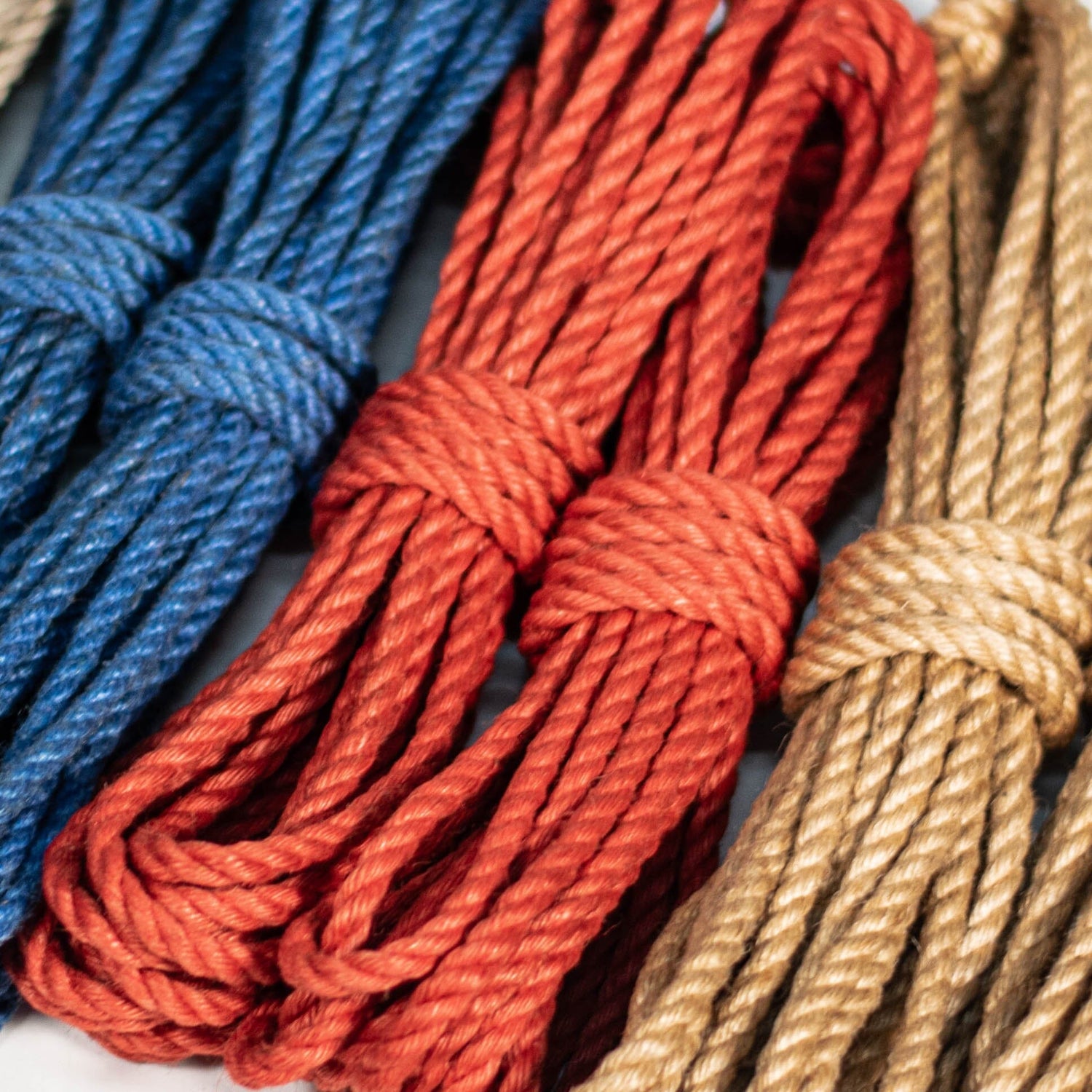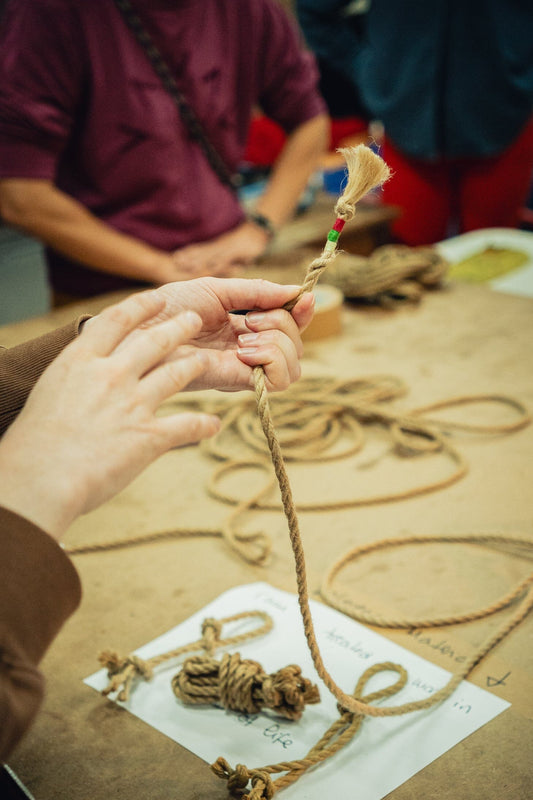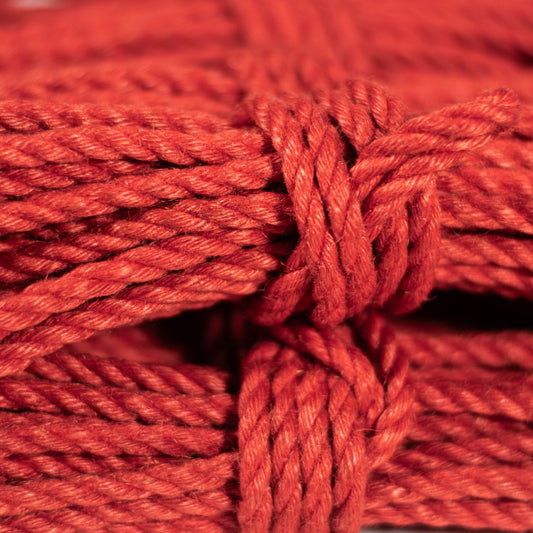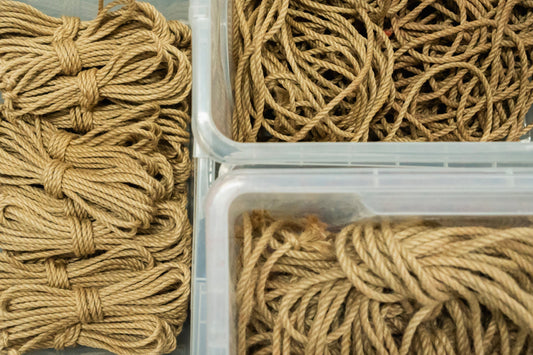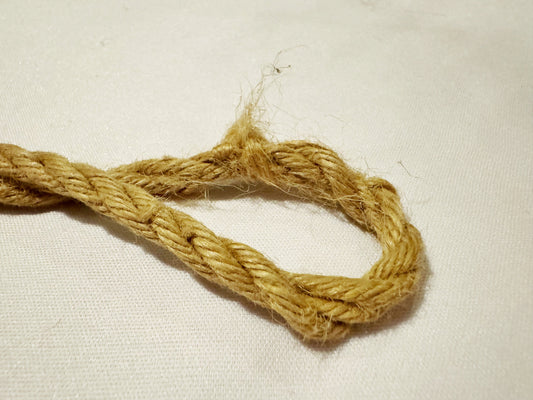After purchasing your new beautiful set of Anatomie shibari ropes, you may want to learn some tips on how to take care of them so that they stay pleasant to use for both you and your partner(s). Here are some of our tips.
Storage
There are several ways to store jute rope but by far the best way to take of them when they are not being used is to hang them. This will allow them to air and encourage them to stay straight. A convenient place to hang them would be over a curtain rail for example. Avoid getting your jute ropes wet as this makes the rope swell and contract, but if they do get wet, you’ll need to dry them ‘under tension’ (for example by tying them to things or using weights).
When transporting ropes, you will want to hank them in some fashion (and there are several ways to do this, so pick one that works for you). Be aware that leaving the ropes hanked for very long periods of time may promote bends and kinks in the rope which you’ll then have to manually straighten when you are ready to use them again. Some people will also throw in a few silica gel bags (the kind that you find inside brand new shoes or purses) to help prevent moisture from damaging the ropes.
Maintenance – dealing with ‘fluff’ and ‘fuzzies’
Your brand new Anatomie Studio ropes come hand treated and ready to use, but they’ll benefit from a little up-keep to help them mature. You might notice the ropes become a little hairy in the beginning - this is very normal. The fluff will disappear over time with more use, but to hasten that people usually lightly ‘burn’ (singe) the ropes by passing them over a gas hob or a camping stove. With the gas on the highest setting, singe the rope at a height of about 8-16cm above the base of the flame, taking about 30-45 seconds per 7.5m rope. You will probably need to repeat the process several times with a new set (maybe once ever week/two weeks depending on how much you use them). After a while the ropes become more stable so you might only need to do this once every month/two months. The ropes will first darken every time you repeat this process, but they will lighten very quickly again after use. We recommend wiping the ropes carefully after singing them to remove the soot. Wiping the rope also promotes the strands to equalise and gives them a nice shiny polish.
Maintenance – dealing with ‘dry’ ropes
Depending on how much you tie, whether you are tying on bare skin or clothing, or on how you are storing your ropes, they may start to become a little dry. This is also very common, but it makes the rope more brittle and so shortens its life. Jute rope needs oil to stay strong and supple. One of the best oils for rope is sebum - from human sweat - so we recommend you tie on bare skin! Second to that, jojoba oil, camellia oil and beeswax are often used as their combined composition is close to sebum. We recommend using our Goo or Lube to moisturise your ropes, and remember that a little goes a long way. Try not to saturate the ropes with oil or they’ll feel heavy. Our rope goo is made of organic beeswax (which has antibacterial properties) and pure cold pressed camellia oil (which has antiseptic properties). The wax helps the oil stay in the ropes, and together they help keep the jute fibres strong. The rope lube is a blend of camellia oil and jojoba oil, so therefore vegan. All three oils and waxes are used in natural cosmetic products and are unscented, so they’re healthy for your hands and skin. Whether you choose lube or goo to treat your ropes will depend on personal preference - the lube is vegan so appeals to many customers because of that, but it it a bit messier to apply (a cloth helps).
Maintenance – dealing with ‘high stranding’
There is a reason in our classes we always teach to ‘pull’ and ‘never to ‘push’ the ropes. The ropes we sell in the studio are ‘single ply’ ropes; they look great and handle beautifully but they’ll require some looking after as the strands can ‘split’ if you’re not careful when tying – in particular when making frictions and knots. If you do notice the 3 strands that make up your ropes becoming uneven (one pulling more than the other, i.e. ‘high stranding’) then you should fix this as soon as possible before putting them away. All you need to do to encourage the strands to go back into their place is to ‘wipe’ the ropes from the middle (the bight) to the ends of the rope. As you wipe, twist your wrist slightly following the direction of the twist of the rope. You might need to undo the end (or ends) of the rope and retie them again.
Maintenance – dealing with a ‘worn bight’
Because in shibari we always tie from the middle of the rope (what we call the bight), this part of the rope tends to wear out faster than the rest of the rope. The ropes are only as strong as their weakest part, so when you see this happen you should consider cutting it into small pieces. It is incredibly useful to have small ‘shit bits’, ‘rats tails’, ‘baby ropes’ (pick you name) as part of your kit.
Have questions? Drop us an email at anatomie.studio@gmail.com.
